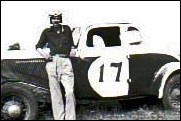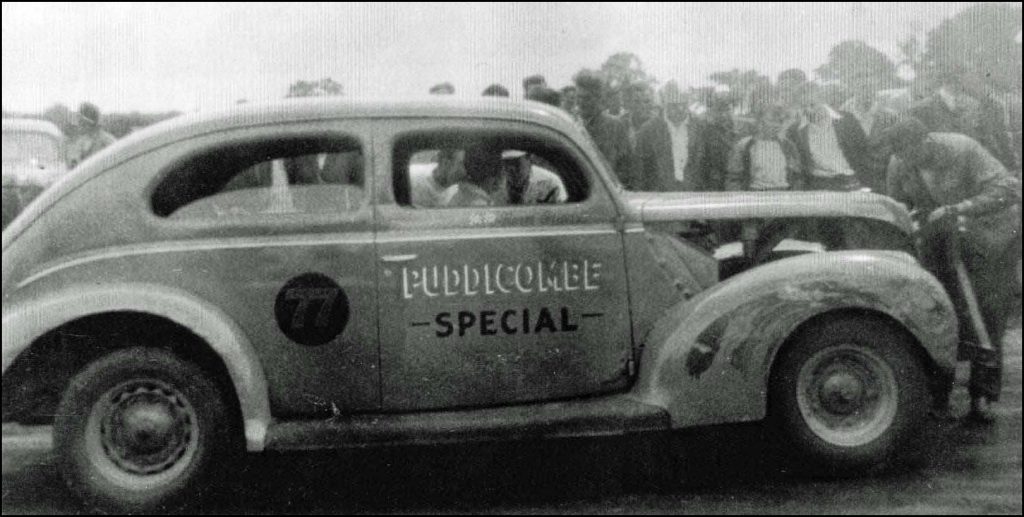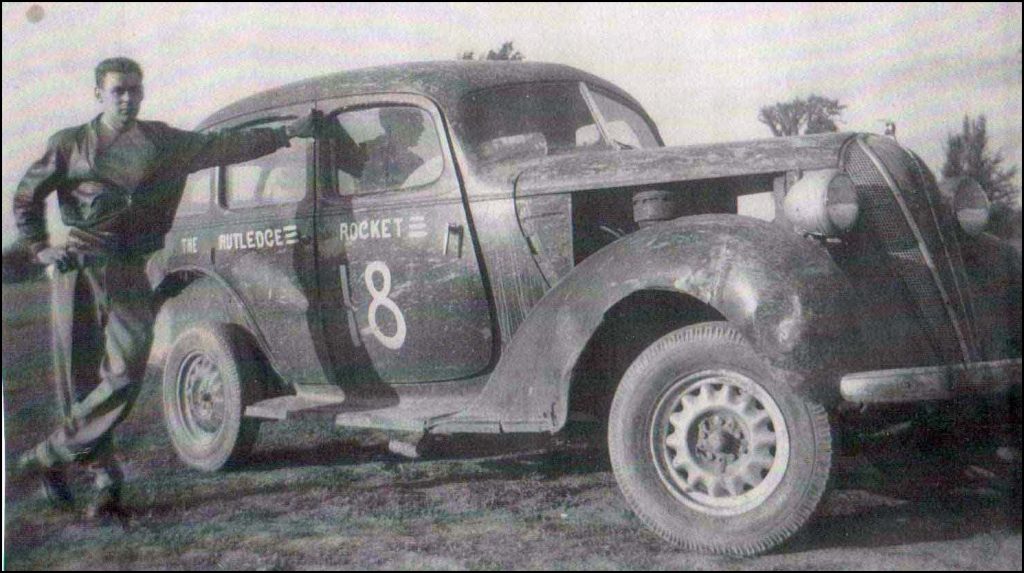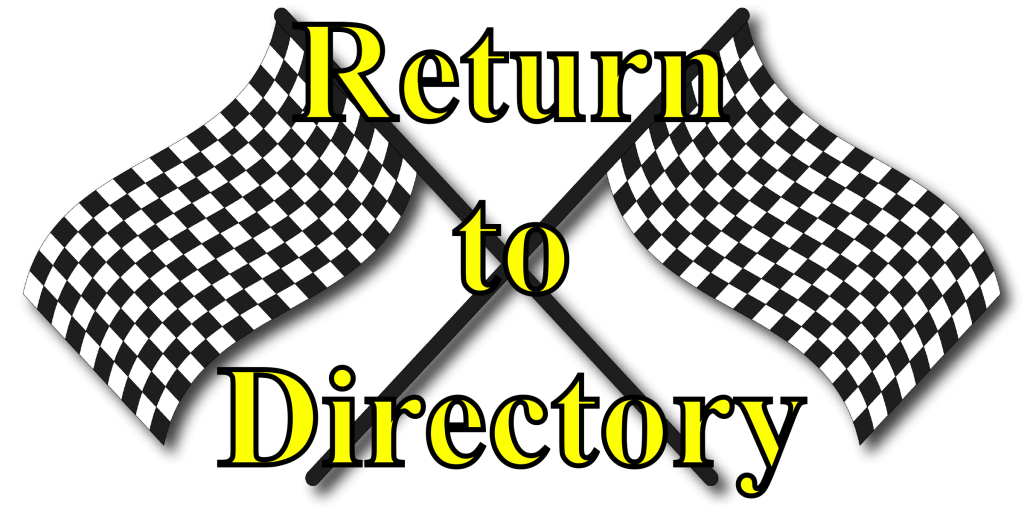Maple Ontario
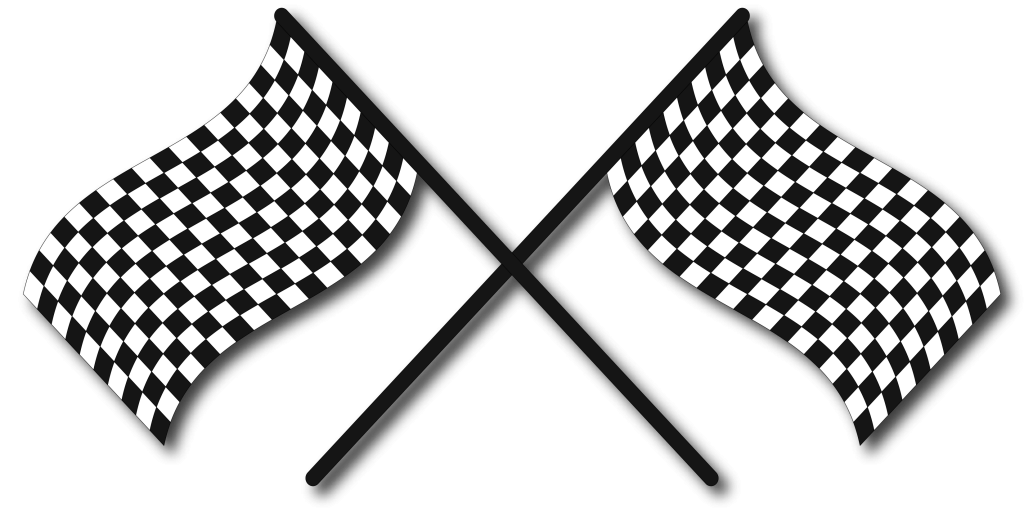
Speedway Park 1950 – 1954
It was May 24th, 1950, opening day at “the new” Speedway Park owned and operated by Harley Morden. There was standing room only as an enthusiastic crowd of 4,000 fans packed the place. There was an ad in the Globe and Mail on Speedway Parks opening day that read;
“SHAW MAY TRY FOR TRACK MARK AT AUTO RACES”
Although this was the first scheduled race day at the new track, there have been previous test sessions. The fastest time from these test sessions belonged to Charlie Fowler as he sped around the track in 33.9 seconds. Lloyd Shaw was preparing his half miler, the “Cooke Special” to set a new track record.
Lloyd Shaw did in fact set the fast time for the half milers at Speedway Park beating Charlie Fowlers practice day lap time. Charlie Fowler, not one to be out done, beat Lloyd Shaw’s time on June 7th, 1950 with a lap time of 32.4 seconds in his red #3 the Markham Meteor.
Pit side there were 18 half milers and enough stock cars for three heats all racing for a total days purse money of $1,000.00. The purse was mainly for the half milers, the stock cars were paid very little in those days although many would argue that the stock cars put on a better show. While the half milers were faster and nicer looking cars than the early stock cars, the stock cars were spinning and crashing more. They were the real crowd pleasers and that did not go unnoticed.
The track promoter Harley Morden announced informed everyone in attendance that afternoon that Speedway Park would host stock car races on Wednesday nights starting at 7:00 pm. Drivers such as Wallie Branston, Mel Sinclair, Lloyd Shaw, Dave Boon, Ted Hogan and Norm Mackereth were there with their stock cars on a regular basis. Most stock cars during this era were driven to and from the track unless they were badly damaged during the racing event.
Wallie Branston was unstoppable during the 1950 racing season. On the night of June 27th he drove his Bardahl Rocket to the checkered flag to win for the fourth straight week. Winning the feature on that particular night earned Wallie, along with five other drivers an entry position in the “Dominion Day” special stock car race.
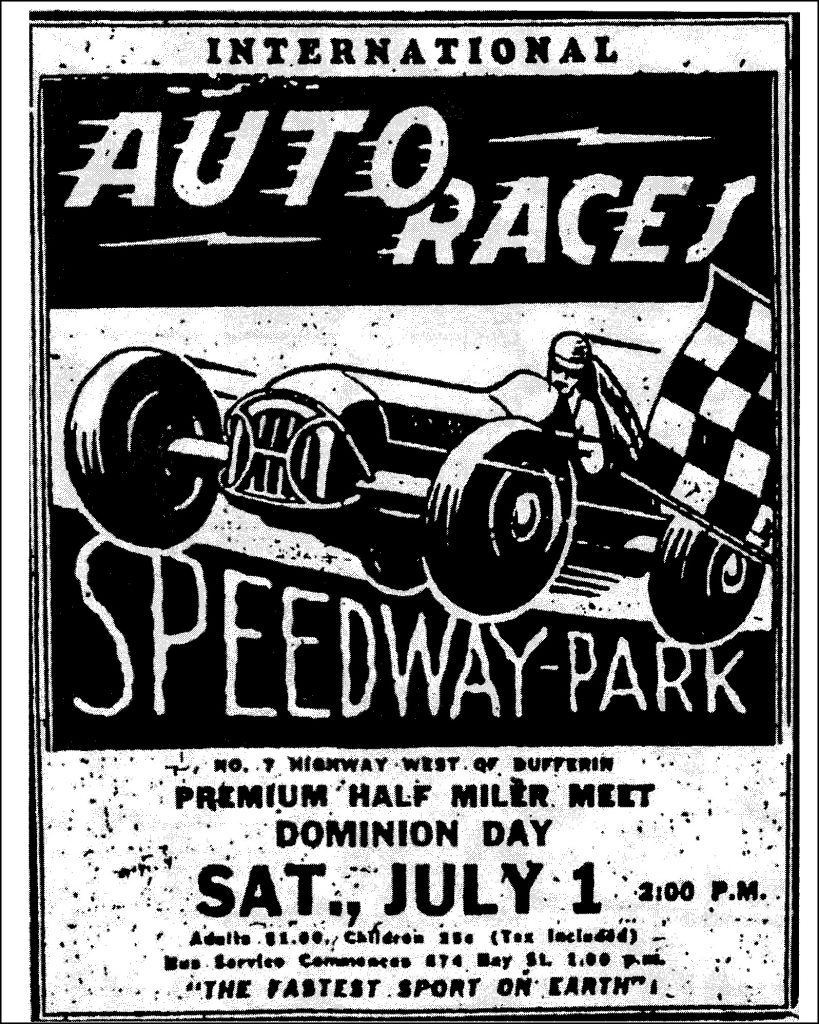
The Dominion Day event at Speedway Park was a special meet for half milers. Some of the American drivers pre-registered to race on Dominion Day were Shorty Fitzgerald, Jimmy Schumacher, Charlie Rowland and Hugh Darragh as well as Canadian drivers such as Jimmy Chandler, Charlie Fowler, Jimmy Rowe and Jack Judges. To everyone’s surprise, the Toronto ace, Ron Huntington and his #4 “the Linda Special” was not entered however it was learned that rookie driver Dave Lefler may drive Ron Huntington’s car.
Dominion Day was only the second event for the half milers at Speedway Park during the 1950 racing season. Harley Morden, being the business man he was, decided to promote the stock cars on Wednesday nights instead of the half milers on a weekly basis.
As auto racing was still relatively new and there were not enough Canadian half milers to put on a good show by themselves, Harley was forced to make this difficult decision. Most of the American drivers had there own local tracks to race at and would not commit to a weekly race event.
The crowd was usually equal to when the half milers were there and the stock car purse money was nowhere near as large as the half milers. For this reason, the stock cars were the weekly show in 1950 and the half milers were at Speedway Park for special events only.
INTERNATIONAL AUTO RACES – PREMIUM HALF MILERS MEET
THE FASTEST SPORT ON EARTH
C.A.R.S. placed this large promotional ad on June 30th in the Telegram.
Also in the June 30th Telegram was the headline;
MIDTOWN SPECIAL RETURNS TO SPEEDWAY PARK SATURDAY
“Lou Cohen’s silver Midtown Special returns to the auto racing scene tomorrow at speedway”. Wallie Branston, the stock car ace was to drive for Lou in the Dominion Day event. I believe this was Wallie’s first ride in a half miler.
Lou first brought his sharp looking Midtown Special out for the opening day at Pinecrest, July 10th, 1948. It was piloted at that time by rookie driver Leroy Teich who had very little seat time in the car before actually racing the car. Teich with his lack of experience raced into turn one leading the pack during Pionecrest’s opening day event, lost control of the car, crashed through the outer guardrail and into a very large tree which brought him to a sudden stop seriously injuring Teich and destroying the car.
Ron Knott also arrived with his green #7 for the Dominion Day event. Ron was seriously injured at a race in Beamsville in 1949 so the half miler veteran, Lloyd Shaw would drive for Ron for that event.
The special stock car race scheduled for this event was to be six cars for ten laps but only four cars showed up. Tom Forbes, Dave Boon, Ted Hogan and Wallie Branston did the best they could to put on a show; it was lacking to say the least.
The same could be said for the results of the Canadian half miler entrants. Wallie Branston in the Midtown Special had problems during a warm-up session, Lloyd Shaw dropped a valve in Ron Knott’s car, Dave Lefler and Jack Judges came together in the third heat. The only Canadian driver to win a race during this special Dominion Day event was Charlie Fowler; he won the third heat for half milers.
Jerry Brown won the 20 lap feature with Cliff Wager second and Herb Wing third to bring the Dominion Day event to an end.
The July 5th headline in the Globe read as follows;
OPPOSITION LOOMS FOR SPEEDWAY ACE
Norm Brioux, an experienced driver from the Jack Kochman Thrill Show would make his first start of the season tonight. Norm had stated earlier on that his car would travel at least as fast as that of Branston’s. This had yet to be proven.
Stock cars in 1950 were reasonably inexpensive to build. It was the fuel, parts and repair that got expensive. Sponsors were few and far between at this time in the sport. Wallie Branston had Bardahl as his sponsor to help with the cost of racing. Some of the other drivers picked up gas money or free parts, possibly free service bay space at a local garage (after business hours) if they put a persons name or a company name on the car.
The arrival of Norm Brioux was the start of one of the biggest changes the auto racing sport had seen to date. Norm had just returned to Canada and had heard about the stock cars at Speedway Park. Naturally he wanted to be a participant so he approached one of the largest Ford Dealerships in Toronto at the time – PUDDICOMBE MOTORS – to be his sponsor. They agreed to sponsor Norm and on July 5th, 1950 Norm showed up at the track with a beautiful1939 two door coupe painted white and yellow with the #77 painted on the door. This type of sponsor was a first for the stock cars.
BRIOUX SNAPS BRANSTON”S WIN STREAK
Was the sports page headline in the next days Telegram. Norm Brioux, in his first night of competition at Speedway Park won the feature race easily. Bruce Waddell was second (20 car lengths back) with John McGiffen and John Urkevich finishing third and fourth.
Norm Brioux and his Sponsor – Puddicombe Motors – brought to the track a level of professionalism that had not yet been seen in the stock car ranks. This team was responsible for getting the stock car division of that era a whole new respect from the media.
Eighteen stock car teams had entered Speedway Park to race on the night of July 12th, 1950. Harley Morden was ecstatic; there had never been so many stock cars before. Just as he had hoped, the popularity of this sport was growing rapidly.
There was a crowd of 4,000 fans at the track for this event. With 18 cars in the pit area, it was bound to be a great show. Wallie Branston took a commanding lead in the 15 lap feature event and went on to take the win. Bruce Waddell was 2nd, Norm Brioux 3rd and Tom Forbes 4th. [There was talk of a challenge race between Wallie and Norm, but it never materialized]
Lloyd Shaw had been running with the leaders in his 1934 Hudson until he lost the right front wheel ending his chances at victory.
Some of the drivers started realizing mid season that while they were racing for a total purse of $500.00, and according to the papers the fan attendance was 4,000 – 5,000 on a regular basis bringing the promoter Harley Morden well over $2,000.00 regularly. This realization led to the formation of the Canadian Stock Car Racing Club.
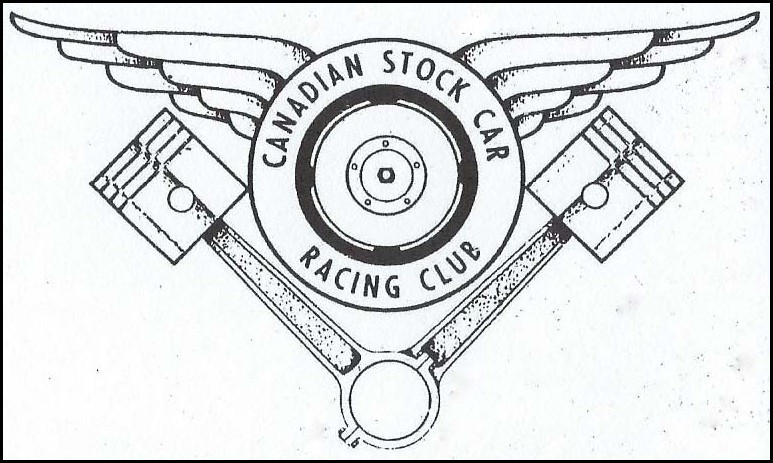
The Canadian Stock Car Racing Club was formed in late 1949 in order that the drivers at “Speedway” could present a united voice to the promoter.
Photo Courtesy of Dave Boon
The next event on the schedule was to be held on what we now call our Civic Holiday, the first Monday in August. This was advertised as a “Premium Meet” with stock cars and sprints both racing that day. On the day of this premium meet there were 5,000 fans in attendance at a cost of $1.00 per adult and 25 cents per child. This event just proved to the stock car drivers that they had done the right in forming the Canadian Stock Car Racing Club. Once the club was formed they would have a little more control over the purse money.
This premium meet, August 7th, 1950 was the return of stock car racing Ace Ted Hogan. Ted was a regular front runner in the ’48 and ’49 seasons but had not yet been seen racing in 1950. During the 1949 season at Speedway Park (the original Pinecrest Speedway) Ted went for a wild ride in one of the most spectacular crashes of the era. Ted and Len Hurley were racing together, Len was high and Ted was low when Ted blew a tire in turn #4 totally destroying his ’37 coupe as he flipped several times. Remember, there were no roll bars in those days.
Starting on August 12th, 1950, the races would be moved to Saturday afternoons instead of the evening shows due to the sun setting earlier, the racing was to start at 2:30 sharp.
It was August 12th, 1950, another former winner returned to the racing scene for the first time this year. Len Hurley was at the first race at Pinecrest on July 10th, 1948. Len had previously proven himself as a driver, but he was also a good mechanic. In the second heat Len started at the rear of the eight car heat but in just a few laps he was leading. He crossed the line at the checkered flag shaving almost 30 seconds off an eight lap heat race. This had many drivers and fans alike wondering, how “stock”, was Len’s stock car. The car was checked and as suspected, his engine was modified beyond what was allowed. No one wanted to send Len home so they allowed him to finish the meet, but under protest.
Len Hurley was a racers racer; he was one of those “good old boys that just wanted to have fun”. All he wanted to do was find ways to go faster. Len won the feature on August 12th, 1950 but due to the engine modifications that exceeded the rule book, the race was given to second place finisher Lloyd Shaw. This decision also raised a lot of questions like; why was Len allowed to race under protest if they were going to strip him of his finishing position?
One week later, August 19th, 1950 saw even more new cars arrive at Speedway Park, George Bowers, Buzz Holland and Carl Rutledge started their racing careers at this event.
Dave Boon rolled his ’34 coupe on the front straight but it was a fairly sturdy car, very little damage was done. The only thing the car needed was 2 quarts of oil which Wallie Branstons sponsor “BARDAHL” supplied.
The 1950 racing season was starting to wind down, September had arrived. The Special event planned for Labor Day was supposed to be for sprints and stock cars. However, Charlie Fowler blew his engine on the Saturday, two days earlier and the only sprint to show up was Lloyd Shaw with his Jaguar powered Cooke Special. Lloyd set a new track record of 31.1 seconds during this Labor Day event. To my knowledge that record was never broken. Later that day, Lloyd backed up his track record with a second track record. He drove his XK 120 Jaguar roadster around Speedway Park in 34.4 seconds.
Track Lighting was installed in preparation for the 1951 season. Speedway Park along with C.A.R.S. was planning on holding weekly races for the stock cars and special events including sprints and stock cars. This proved to be the beginning of the end of Speedway Park. A new facility at Oakwood Stadium located at Oakwood Avenue and St. Clair Avenue in Toronto had started running stock car events on a weekly basis. Most of the competitors went there as it was more convenient leaving Speedway Park with only a few cars.
Harley Morden made it very clear that any driver racing at Oakwood Stadium would no longer be welcome at his track. The Toronto area saw its first racing fatality in July of 1951, Don Whitson rolled his car in a heat race causing fatal injuries.
It was much the same in 1952. The CNE Stadium had opened and many stock cars went their to race as well as the “new” Pinecrest Speedway had opened midway through the season. Joe Cappy and Norm Smith, the two promoters of Oakwood Stadium in 1951 had bought the original ½ mile Pinecrest Speedway site and built the legendary ¼ mile oval, also named Pinecrest Speedway on that site.
In 1953 Lloyd Shaw and Pigott Motors (Lloyd’s employer at the time) tried to revitalize Speedway Park. The track was redone, the stands were repaired. Stock car races and sprint car races were held, big name drivers such as Vern Harriman, Tom Cherry, Milt Goodwin were brought in to race and attract the crowds but the large crowds of previous years were gone and the 1953 season ended early on.
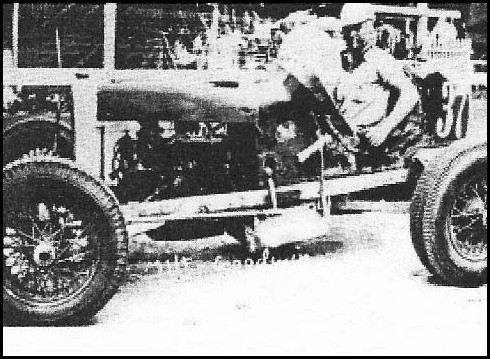
Milt Goodwin raced at Speedway Park on several occasions and did very well there.
(If you look closely, just below the car, this photo is signed)
Photo Courtesy of Dave Boon
Harley Morden promoted a few special events at Speedway Park in 1954. The crowds returned when he brought in big name drivers to race with the locals. Unfortunately, with Pinecrest and the CNE running weekly races, most of the locals were not available.
Back in 1950, the drivers had no choice where they raced, “Speedway Park” was it, there were no other tracks in the area. Now, in 1954, there were other race tracks to race at. Speedway Park was no longer the drivers only choice of where to race.
The CNE and Pinecrest were both much smaller race tracks. This meant more competition, less damage if wrecked and more door to door racing which the fans loved.

Tom Cherry of Muncie Indiana in his flathead power takes the Checkered Flag at Speedway Park in 1954Courtesy of Dave Boon

